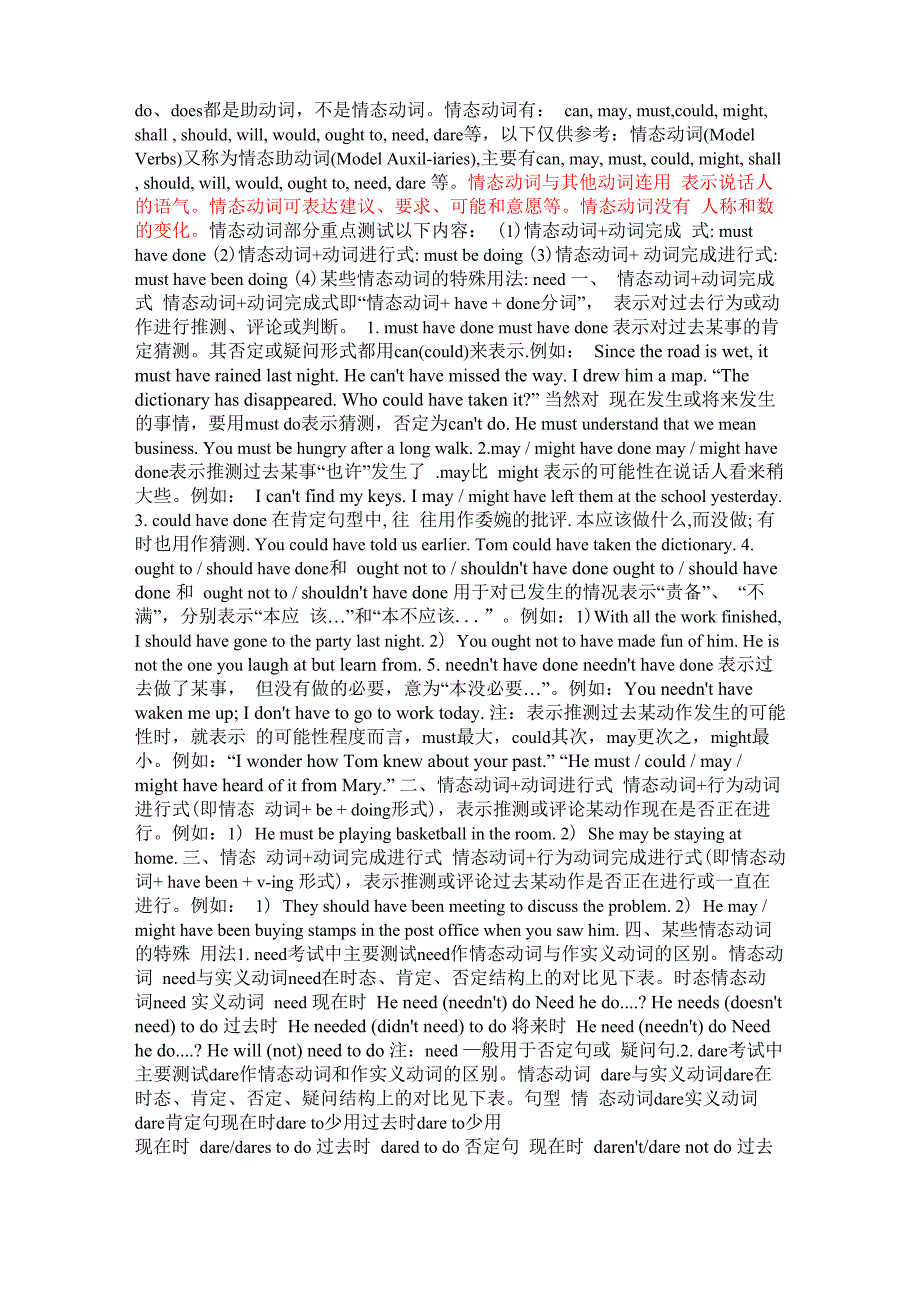 情态动词和助动词
情态动词和助动词


《情态动词和助动词》由会员分享,可在线阅读,更多相关《情态动词和助动词(2页珍藏版)》请在装配图网上搜索。
1、do、does都是助动词,不是情态动词。情态动词有: can, may, must,could, might, shall , should, will, would, ought to, need, dare等,以下仅供参考:情态动词(Model Verbs)又称为情态助动词(Model Auxil-iaries),主要有can, may, must, could, might, shall , should, will, would, ought to, need, dare 等。情态动词与其他动词连用 表示说话人的语气。情态动词可表达建议、要求、可能和意愿等。情态动词没有 人称和数的变化
2、。情态动词部分重点测试以下内容: (1)情态动词+动词完成 式: must have done (2)情态动词+动词进行式: must be doing (3)情态动词+ 动词完成进行式: must have been doing (4)某些情态动词的特殊用法: need 一、 情态动词+动词完成式 情态动词+动词完成式即“情态动词+ have + done分词”, 表示对过去行为或动作进行推测、评论或判断。 1. must have done must have done 表示对过去某事的肯定猜测。其否定或疑问形式都用can(could)来表示.例如: Since the road is w
3、et, it must have rained last night. He cant have missed the way. I drew him a map. “The dictionary has disappeared. Who could have taken it?” 当然对 现在发生或将来发生的事情,要用must do表示猜测,否定为cant do. He must understand that we mean business. You must be hungry after a long walk. 2.may / might have done may / might
4、 have done表示推测过去某事“也许”发生了 .may比 might 表示的可能性在说话人看来稍大些。例如: I cant find my keys. I may / might have left them at the school yesterday. 3. could have done 在肯定句型中, 往 往用作委婉的批评. 本应该做什么,而没做; 有时也用作猜测. You could have told us earlier. Tom could have taken the dictionary. 4. ought to / should have done和 ought
5、not to / shouldnt have done ought to / should have done 和 ought not to / shouldnt have done 用于对已发生的情况表示“责备”、 “不满”,分别表示“本应 该”和“本不应该.”。例如:1)With all the work finished, I should have gone to the party last night. 2) You ought not to have made fun of him. He is not the one you laugh at but learn from. 5
6、. neednt have done neednt have done 表示过去做了某事, 但没有做的必要,意为“本没必要”。例如:You neednt have waken me up; I dont have to go to work today. 注:表示推测过去某动作发生的可能性时,就表示 的可能性程度而言,must最大,could其次,may更次之,might最小。例如:“I wonder how Tom knew about your past.” “He must / could / may / might have heard of it from Mary.” 二、情态动词
7、+动词进行式 情态动词+行为动词进行式(即情态 动词+ be + doing形式),表示推测或评论某动作现在是否正在进行。例如:1) He must be playing basketball in the room. 2) She may be staying at home. 三、情态 动词+动词完成进行式 情态动词+行为动词完成进行式(即情态动词+ have been + v-ing 形式),表示推测或评论过去某动作是否正在进行或一直在进行。例如: 1) They should have been meeting to discuss the problem. 2) He may / m
8、ight have been buying stamps in the post office when you saw him. 四、某些情态动词的特殊 用法1. need考试中主要测试need作情态动词与作实义动词的区别。情态动词 need与实义动词need在时态、肯定、否定结构上的对比见下表。时态情态动 词need 实义动词 need 现在时 He need (neednt) do Need he do.? He needs (doesnt need) to do 过去时 He needed (didnt need) to do 将来时 He need (neednt) do Need
9、he do.? He will (not) need to do 注:need 般用于否定句或 疑问句.2. dare考试中主要测试dare作情态动词和作实义动词的区别。情态动词 dare与实义动词dare在时态、肯定、否定、疑问结构上的对比见下表。句型 情 态动词dare实义动词dare肯定句现在时dare to少用过去时dare to少用现在时 dare/dares to do 过去时 dared to do 否定句 现在时 darent/dare not do 过去时 dared not do 现在时 do/does not dare (to) do 过去时 did not dare (
10、to) do 疑问句 现在时 Dare he do? 过去时 Dared he do? 现在时 Do you/Does he dear (to) do?过去时 Did he dare (to) do 3. can 和 may 考试中主要测试can, may或 could, might表示可能性的区别及对may构成的疑 问句的回答。(1) can, could, may, might都可以表示可能性.can, could表示潜在的可能性或理论上或逻辑判断 上存在的可能性;而may, might则表示事实上的可能性。此外,can还具有“有能 力”的意思,而may与might则不具此意。例如:Acc
11、ording to the weather forecast, it may rain tomorrow. Any man with a little sense can see that he is wrong. ( 2) May I / we?这一类疑问句的肯定回答为Yes, please.或Certainly;否定回答为Please dont.或No, you mustnt.例如: “May we leave now?” “No, you mustnt. You havent finished your home work yet.” 4. can 和 be able to can 与
12、be able to 都可 以表示能力,但两者在用法上有点差异:can (could)表示主观能力,不表示意愿, 它的将来时用will be able to; be able to表示主观意愿,强调要克服困难去做某事。 例如: 1) My grandma is over seventy, but she can still read without glasses. 5. must 和 have to must 和 have to 都可以表示“必须”,但有几点区别:(1) must 强调“内在的职责”、“义务”,而have to强调“外界压力”、“不得已而为之”。(2) have to可用于多
13、种时态,而must般用于现在时,其过去时与将来时分别由had to 与shall / will have to代替。(3)在回答must引起的问题时,如果是否定的答复, 不能用mustnt,而要用neednt或dont have to,因为mustnt是“一定不要”、“一定 不能”的意思。例如: You must come to the classroom before eight. 2) It is raining hard outside, but I have to leave now. 3) “Must we do it now?” “No, you neednt.” 6. used
14、to +do, be used to +doing和be used to +do ( 1)used to +v意为“过去常常”,“过 去一直”;be used to +v-ing / n (名词)意为“习惯于”;be used to +v意为“被用来(做某事)”。(2)used to只表示过去,而be used to +v-ing / n可表示现在、过 去或将来。例如: 1) He used to smoke. Now he doesnt. 2) Hes quite used to hard work / working hard. 3) The knife is used to cut br
15、ead. 7用作情态动词的其他短语 would rather, would sooner, would (just) as soon, had rather, had better, had sooner, can not but, may (just) as well等可用作情态动词。例如:1) The soldier would sooner die than surrender. 2) The brave soldier would as soon die as yield to such an enemy. 3)Id rather walk than take a bus. 4)If you dont like to swim, you may just as well stay at home.注:这些短语后一般直接跟动词原形.would (had) rather, would (had) sooner, would (just) as soon后可跟that引导的从句,that常省去,从句要用 虚拟语气。对现在和将来的假设用过去时,对过去的假设用过去完成时。例如: 1) I would rather you came on Sunday. 2) I would sooner you hadnt asked
- 温馨提示:
1: 本站所有资源如无特殊说明,都需要本地电脑安装OFFICE2007和PDF阅读器。图纸软件为CAD,CAXA,PROE,UG,SolidWorks等.压缩文件请下载最新的WinRAR软件解压。
2: 本站的文档不包含任何第三方提供的附件图纸等,如果需要附件,请联系上传者。文件的所有权益归上传用户所有。
3.本站RAR压缩包中若带图纸,网页内容里面会有图纸预览,若没有图纸预览就没有图纸。
4. 未经权益所有人同意不得将文件中的内容挪作商业或盈利用途。
5. 装配图网仅提供信息存储空间,仅对用户上传内容的表现方式做保护处理,对用户上传分享的文档内容本身不做任何修改或编辑,并不能对任何下载内容负责。
6. 下载文件中如有侵权或不适当内容,请与我们联系,我们立即纠正。
7. 本站不保证下载资源的准确性、安全性和完整性, 同时也不承担用户因使用这些下载资源对自己和他人造成任何形式的伤害或损失。
